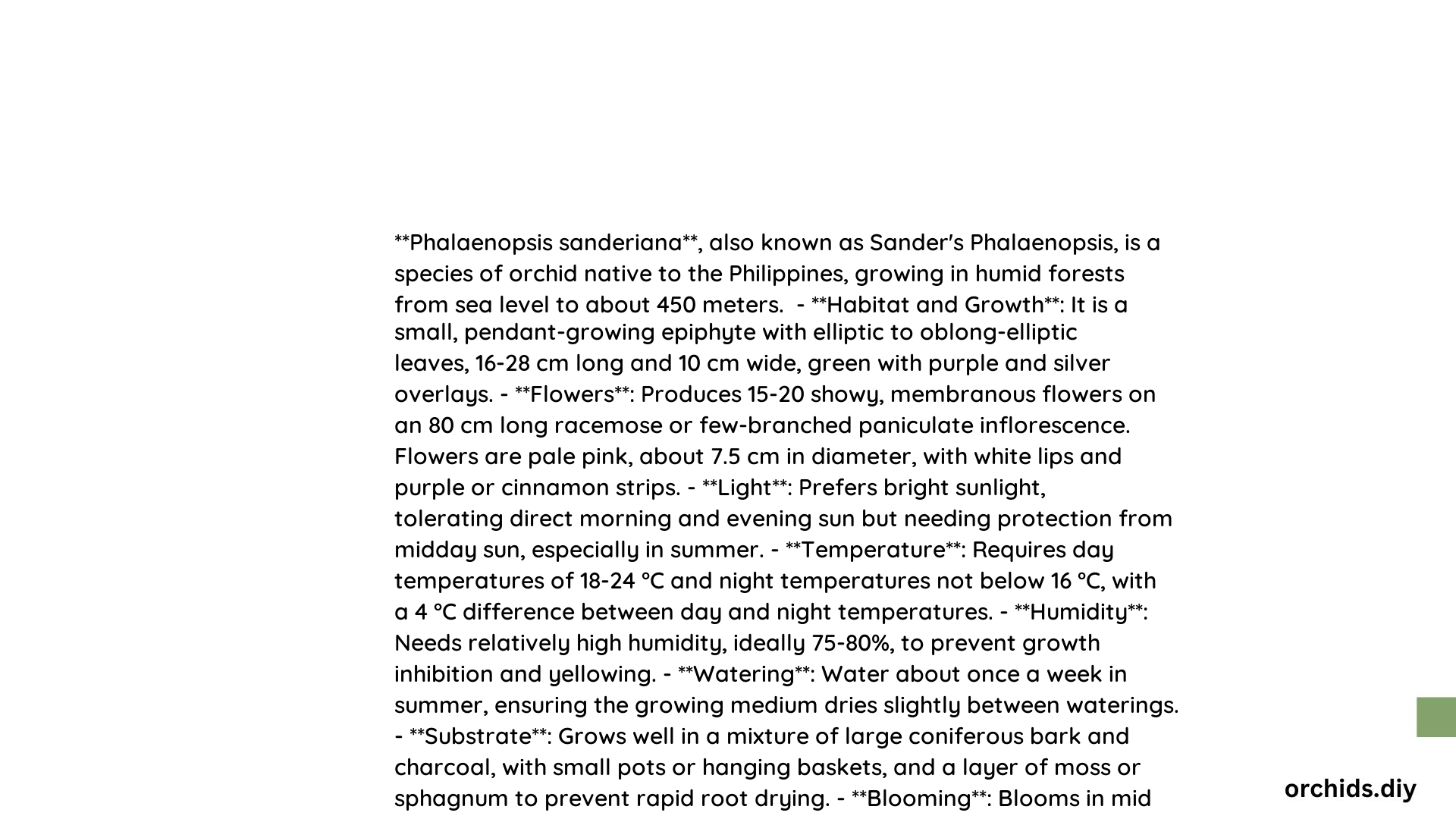Phalaenopsis sanderiana, a stunning orchid species, is prized for its elegant flowers and adaptability to indoor environments. Native to the Philippines, this orchid thrives in moderate temperatures and high humidity. Known for its large, flat flowers in shades of pink and white, P. sanderiana is a popular choice among orchid enthusiasts and collectors. This guide explores its care requirements, propagation methods, and unique characteristics.
What are the key characteristics of Phalaenopsis sanderiana?
Phalaenopsis sanderiana is distinguished by its:
- Large, flat flowers typically in pink or white shades
- Thick, fleshy leaves
- Epiphytic growth habit
- Long-lasting blooms
- Adaptability to indoor cultivation
This species is part of the larger Phalaenopsis genus, commonly known as moth orchids due to their wing-like flower appearance.
What are the optimal growing conditions for Phalaenopsis sanderiana?

Temperature Requirements
P. sanderiana thrives in moderate temperatures:
- Daytime: 18-24°C (64-75°F)
- Nighttime: Not below 16°C (61°F)
- Ideal night-day temperature difference: 4°C (7°F)
Humidity Needs
High humidity is crucial for this orchid:
- Minimum: 60%
- Optimal range: 75-80%
Maintaining proper humidity prevents leaf yellowing and growth stagnation.
Light Conditions
P. sanderiana prefers bright, indirect light:
- Avoid direct sunlight, especially during midday
- Ideal placement: Near a south-facing window with shading
- Light intensity: Bright but filtered (specific lux not provided)
- 70% shading recommended to prevent sunburn
How should Phalaenopsis sanderiana be watered?
Proper watering is critical for the health of P. sanderiana:
- Frequency depends on temperature and growing medium
- Water more often in warmer conditions
- Allow the substrate to dry between waterings
- For plants on blocks:
- Water daily in the morning
- Ensure roots dry by evening
- For potted plants:
- Allow excess water to drain freely
- Remove standing water from the plant’s crown
Misting the plant on hot days can increase humidity, but ensure leaves dry by evening to prevent fungal growth.
What is the ideal potting mix for Phalaenopsis sanderiana?
The best potting mix for P. sanderiana consists of:
- Large bark pieces from coniferous trees
- Charcoal
This mixture provides:
– Excellent drainage
– Adequate aeration for roots
– Moisture retention without waterlogging
When growing on blocks, a thin layer of moss between the roots and block can help retain moisture without compromising oxygen supply.
How can Phalaenopsis sanderiana be propagated?
There are several methods to propagate P. sanderiana:
- Meristem Culture:
- Advanced laboratory technique
- Involves tissue culture methods
-
Not typically feasible for home growers
-
Division:
- Suitable for mature plants with multiple growths
-
Steps:
a. Carefully separate the plant into sections
b. Ensure each section has at least one growth eye or pseudobulb
c. Verify presence of sufficient roots and leaves in each division
d. Pot divisions in appropriate growing medium -
Keiki Production:
- Natural method of propagation
- Steps:
a. Allow the orchid to produce a keiki on its flower spike
b. Wait for the keiki to develop its own roots and leaves
c. Carefully remove the keiki from the mother plant
d. Pot the keiki in suitable growing medium
What are the flowering characteristics of Phalaenopsis sanderiana?
While specific details are limited in the available sources, general characteristics include:
- Flower Shape: Large, flat petals resembling a moth in flight
- Colors: Typically pink or white, with potential variations
- Bloom Duration: Generally long-lasting, like other Phalaenopsis species
- Fragrance: Not specifically mentioned in the sources
How to care for Phalaenopsis sanderiana during different seasons?
Seasonal care adjustments for P. sanderiana:
| Season | Temperature | Watering | Light |
|---|---|---|---|
| Spring | Gradually increase | Increase frequency | Increase exposure |
| Summer | Maintain 18-24°C | More frequent, monitor humidity | Provide 70% shade |
| Fall | Gradually decrease | Reduce frequency | Decrease exposure |
| Winter | Maintain above 16°C | Less frequent, avoid overwatering | Supplement with grow lights if needed |
What are common issues in growing Phalaenopsis sanderiana?
- Root Rot:
- Caused by overwatering or poor drainage
-
Prevention: Use well-draining potting mix, avoid water stagnation
-
Sunburn:
- Results from excessive direct sunlight
-
Prevention: Provide 70% shade, especially during peak sun hours
-
Dehydration:
- Occurs in low humidity or underwatering
-
Prevention: Maintain humidity above 60%, water appropriately
-
Pest Infestations:
- Common pests include mealybugs and spider mites
- Prevention: Regular inspection, maintain cleanliness, use appropriate treatments if necessary
By understanding these care requirements and potential issues, growers can successfully cultivate Phalaenopsis sanderiana, enjoying its beautiful blooms and lush foliage.
